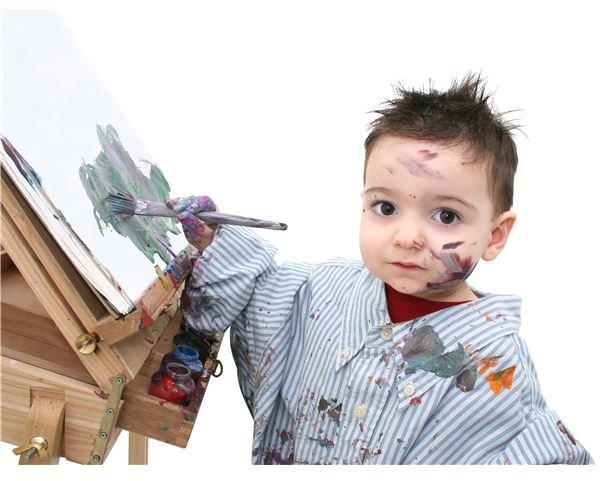A Guide to Pre-K: 56 Lesson Plans and Activities
Developmental Needs
Prekindergarten programs include children from the ages of about four until close to the age of six. While this is a very small age gap,
the year before a child starts kindergarten is vital to their development.
Many children will learn how to behave in groups, how to cooperate with others, appropriate classroom behavior, and interpersonal skills in their pre-K year. To be able to appropriately plan for these students, it is important to understand their development and what you can expect from a prekindergartener. Browse through these basics to learn what you need to know:
- Cognitive Development
- Emotional Development
- Social Development
- Fine Motor Development
- Developmental Skills Assessment
Begin the Day in Pre-K
The beginning of the day will become a familiar routine for your pre-K students. There are a number of ways you can begin the day, including but not limited to a circle time activity, a free choice activity, or a sign-in activity. Beginning the day in the same way each day will give the children a sense of stability and they will learn to anticipate transition times. Before long, the children can tell you what activities will come next as well as be able to explain the routine to visitors and new classmates.
- Pre-K Attendance and Sign In Ideas
- Terrific Transitions for Pre-K
- Circle Time: Begin with a Routine
- Creating a Visual Schedule
- Calendar Time: Teaching Days, Weeks and Months
Art Activities and Lesson Plans
Art and sensory activities usually take up a good portion of the day. Through art, children are able to express themselves creatively, experiment with color and shape, work cooperatively on group projects, and feel a sense of accomplishment when they complete a craft or art piece.
Teacher directed art projects are also a good exercise for pre-K students to practice listening and following directions. Child centered art and craft activities give children a chance to experiment with a number of different materials and create in their own way. Check out some of these ideas for pre-K art, sensory and craft lessons.
- Multicultural Art Experiences
- Peace Related Art
- Pre-K Multicultural Crafts
- Summer Art Activities
- Old Mother Hubbard Craft
- Combining Math and Art: Rainbow Activities for Pre-K
- Firefly Art
- Scarecrow Shape Project
- 8 Preschool Crafts for Thanksgiving
- Seashells and Sand
- Winter Holiday Crafts
- Making Personalized Christmas Cards
Science and Discovery Activities
Prekindergarten science is all about discovering the world around you. Studying items with magnifying lenses, taking nature walks, and discussing mammals, birds and reptiles can all be a part of a pre-K science curriculum. Set up a science discovery center in your classroom with lots of books with photographs of animals in their native environments, magnifying lenses, magnets and other appropriate science materials. Allow children to explore these materials on their own, but provide a few guided activities for the class, too. Check out some of these stellar ideas for including science in your pre-K curriculum.
- Winter Science
- All About Me: Pre-K Science
- Understanding Camouflage
- Color Mixing Science Experiments
- Learning About Shadows
- Science at the Zoo
- Planting Seeds Lesson Plan
- Pre-K Garden Theme
- Pre-K Lesson Plan: The Properties of Matter
- Living and Non-living Things
- Exploring Human Body Systems
- Germs: Pre-K Health Lessons
- Discovery Learning in Pre-K Classrooms
- Nature Walk Activities
Language and Literacy
Prekindergarten students can be categorized as emergent readers. By this age, many pre-K children can recognize their own names in print and may even be able to write a few alphabet letters. Create a print-rich environment in your pre-K classroom by including books and signs in every center, and finding opportunities for including environmental print throughout the room. In addition to these simple classroom fixes, be sure to include several opportunities throughout the day for early literacy activities.
- Dr. Seuss Activities
- Sight Word Basics
- Interactive Reading Activities
- The Book Nook
- Pre-K Reading and Writing Strategies
- Author Studies for Young Children
- Eric Carle Lesson Plan
- Jan Brett Lesson Plan
- <em>The Carrot Seed</em> Lesson Plan
- <em>The Three Billy Goats Gruff</em> Lesson Plan
- Language Arts
- Rhyming Songs for the Pre-K Classroom
- Letter Matching Activities
Fun and Learning Across the Curriculum
Never underestimate the power of fun! Children learn best when the material presented to them is relevant to their lives and interests, and also when they are actively engaged. One of the perks of being a pre-k teacher is that you get to plan lots of fun activities and lessons that will keep children engaged and having fun while they are learning important skills. Try a few of these activities in your classroom and add a dash of fun to your day.
- Ecology: Keeping the Ocean Clean
- Pre-K Pirate Theme
- 100th Day of School Project
- Math Games with Toys
- Flannel Board Activities
- Space Theme for Pre-K
- Let’s Go To The Circus! A Pre-K Lesson Plan
When planning a curriculum, keep in mind that pre-K lesson plans and activities should, first and foremost, be fun and engaging. Pre-kindergarten is a child’s first formal introduction into a school environment. Make their foundation a positive one by providing appropriate, engaging and challenging lesson plans and activities throughout the year.
